“Artificial intelligence is the new electricity.” —Andrew Ng
And honestly, he’s right.
AI is quietly running the world, predicting what you’ll watch next, optimizing supply chains across the globe, and even helping businesses make smarter decisions, and chances are, you’re already interacting with it every single day.
According to McKinsey’s 2025 Global AI Survey, 78% of organizations are already using AI, showing how quickly businesses are adopting technology that can think and act.
But not all AI works the same way. Some AI acts, some creates, and some can even set their own goals and figure out how to achieve them.
That’s where the three major types come in: Agentic AI, AI agents, and Generative AI. Each has a distinct role, unique capabilities, and specific use cases.
So here’s the question for you:
Which type of AI matters most to you, and how could you use it to make your work and life easier?
Let’s figure that out together in this blog!
What Is Agentic AI: Intelligent Autonomy and Future Growth Explained
Agentic AI is the future of artificial intelligence. It’s a type of AI that can set its own goals, make decisions, and take independent actions to achieve those goals. Unlike traditional AI that only follows instructions or performs predefined tasks, Agentic AI thinks ahead, plans strategies, and adapts based on outcomes.
Table of Contents
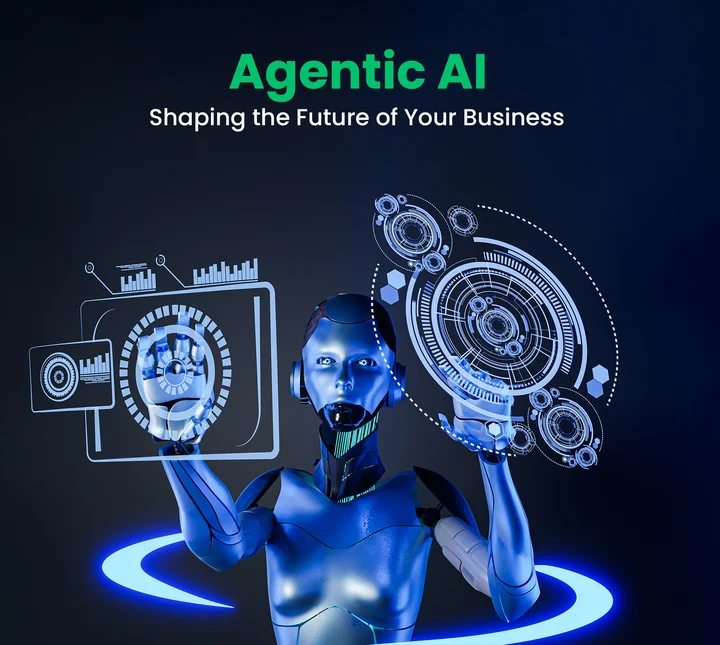
As per recent research, the Agentic AI market could expand from about USD 5.2 billion in 2025 to nearly USD 196.6 billion by 2034, highlighting the massive growth expected in the coming decade. At its core, Agentic AI is about intelligent autonomy that can operate with minimal human guidance.
Let’s say you run a small eCommerce business. You want to boost customer engagement, but you don’t have time to analyze data, create campaigns, or monitor results.
An Agentic AI system could handle it all, analyzing behavior, designing offers, scheduling outreach, and adjusting strategies in real time.
It’s like having a highly skilled employee who never sleeps and constantly learns from every decision.
Is your business missing out on intelligent growth? With Agentic AI, you can build systems that think, learn, and act for you.
What Are AI Agents: Smarter Task Management and Automation
If Agentic AI is the future of autonomous intelligence, then AI agents are its versatile helpers in the present.
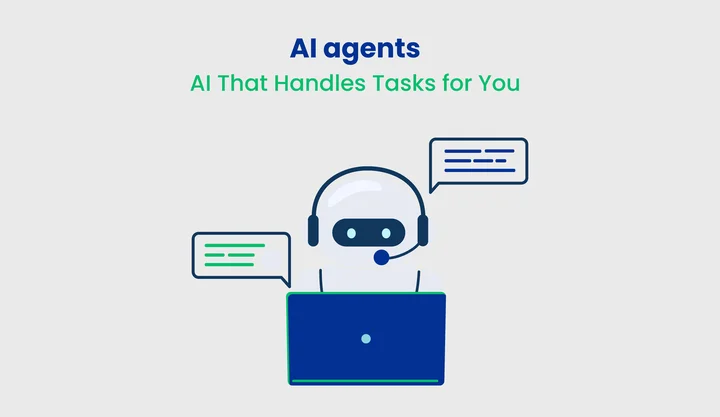
In fact, the global AI agents market is already valued at around $7.92 billion in 2025 and is projected to hit nearly $236.03 billion by 2034, a clear sign of their growing importance. These are smart systems built to observe, decide, and act without needing step-by-step instructions.
They take care of specific tasks on their own, giving you more room to focus on the bigger picture.
Now, picture a network of AI agents running inside your business: one tracks sales trends, another manages inventory, while a third handles customer interactions. They exchange insights, coordinate smoothly, and keep everything on track in real time.
Simply put, AI agents are here to make work easier, faster, and more efficient.
What Is Generative AI: Content Generation and Creative Applications
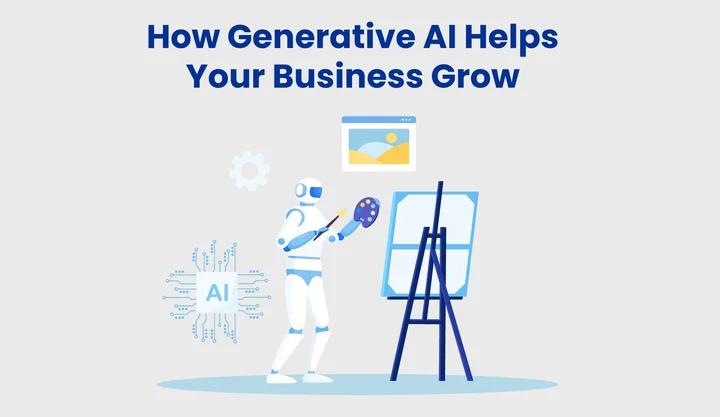
Generative AI is your creative powerhouse.
According to Bloomberg, the generative AI market size is expected to reach $1.3 trillion, highlighting its growing impact across industries. It produces text, images, videos, and even code, giving businesses a powerful way to generate fresh ideas and content.
It works by learning patterns from large datasets, called foundation models, and then generating outputs that mimic or expand on what it has learned.
Imagine you need personalized learning content for students, a product design mockup, or even a piece of software code. A Generative AI model can produce drafts, concepts, or creative suggestions in seconds.
It doesn’t make decisions or plan strategies like Agentic AI, nor does it actively manage tasks like AI agents. Instead, it enhances human creativity and productivity, serving as a co-creator rather than a decision-maker.
What Are the Primary Differences Between Agentic AI, AI Agents, and Generative AI?
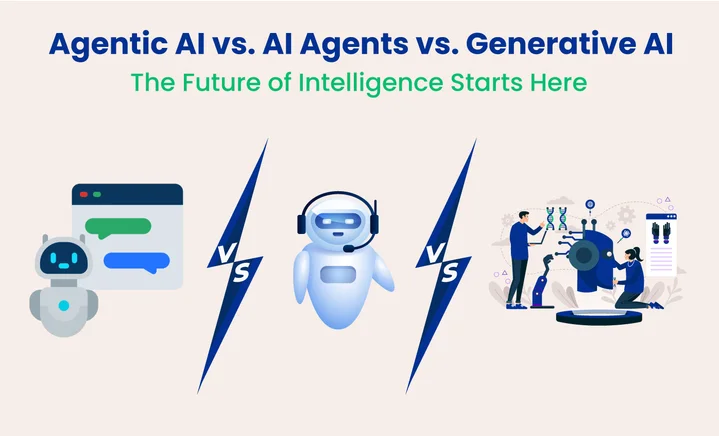
You’ve met the three types of AI, and now it’s time to see how they really compare. Think of it like choosing teammates for a big project: each has unique strengths, and knowing who does what makes all the difference.
You might wonder,
- Which one should handle the strategy?
- Which one can take on creative tasks?
- Which one simply gets things done for me?
This section will break it all down so you can spot the differences quickly and understand which AI could be your perfect match.
| Feature | Agentic AI | AI Agents | Generative AI |
|---|---|---|---|
| Purpose | Sets and achieves goals independently, handling complex tasks on its own. | Performs specific tasks without step-by-step instructions. | Produces new content like text, images, videos, or code. |
| Decision-Making | Makes goal-directed decisions without needing constant guidance. | Makes decisions within the scope of assigned tasks. | Does not make decisions; generates outputs based on prompts. |
| Adaptability | Learns from outcomes and adjusts strategies over time. | Responds to environmental changes and coordinates with other agents. | Learns patterns from data but requires prompts to generate content. |
| Interaction | Operates with minimal supervision, planning, and executing actions independently. | Observes, analyzes, and acts within defined tasks. | Reacts to prompts to create content or suggestions. |
| Complexity Handling | Can manage multi-step, interconnected processes and adapt strategies dynamically. | Handles tasks individually or in coordination, but limited to defined workflows. | Generates outputs but does not handle multi-step processes or interdependencies. |
| Autonomy Level | High. Sets goals, plans, and executes without human intervention. | Medium. Acts within tasks but may need guidance for broader objectives. | Low. Requires prompts and human input for meaningful outputs. |
| Best For | Strategic autonomy, complex problem-solving | Task management, coordination, and operational support | Content creation, design, coding, creative work |
Real-World Use Cases: How Is AI Making an Impact Today?
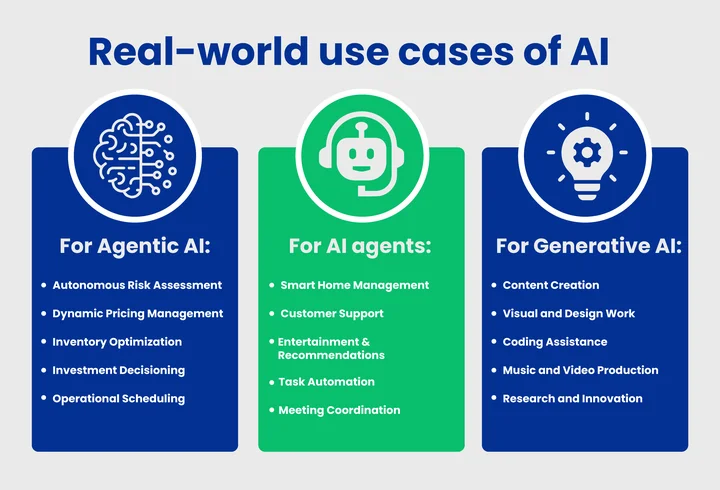
You’ve seen how these three types of AI differ, but seeing their differences in action really helps bring it all to life. Each type has its own strengths, and understanding how they are used today can give you ideas for how to apply them in your own work or projects.
Let’s take a closer look at how they are making a difference in the real world:
- Agentic AI: Smarter Decisions and Independent Actions
Agentic AI takes goals you set and figures out how to achieve them independently, learning and adapting as it goes.Here’s where it shines:- Autonomous Customer Experience: Predicts user needs and adjusts interactions automatically.
- Operational Optimization: Plans supply routes, manages inventory, or optimizes workflows in logistics and eCommerce.
- Research and Innovation: Designs experiments, monitors results, and pivots strategies in product development or scientific research.
As we move forward in 2025 and beyond, many organizations will be looking for trustworthy Agentic AI development services, both to get real value from this shift and to create a future where smart systems work hand in hand with human creativity.
- AI Agents: Managing Tasks and Keeping Systems in Sync
AI agents focus on handling tasks independently and coordinating across systems. They might not set their own goals, but they make your life easier by keeping things running smoothly.For example:- Smart Home Management: Alexa and Google Home coordinate lighting, security, and climate control.
- Customer Support: Manage routine queries and escalate complex issues automatically.
- Entertainment & Recommendations: Platforms like Spotify curate playlists and suggest content in real time.
AI agents are like reliable helpers; they keep tasks on track while you focus on the bigger picture. If you want to integrate these capabilities into your business, AI agents consulting services can help you set them up and get them running efficiently.
- Generative AI: Advancing Creativity and Content Innovation
Generative AI focuses on creating content and ideas. It’s your go-to AI for anything that requires thinking outside the box.- Content Creation: Tools like Jasper can generate email newsletters, training guides, internal documentation, or presentation slides in seconds.
- Visual and Design Work: Platforms such as DALL-E or Midjourney generate illustrations, product mockups, and visual concepts from simple prompts.
- Coding Assistance: GitHub Copilot helps developers write code faster and more efficiently by suggesting snippets and functions.
- Music and Video Production: AI like AIVA can compose music, while Runway can generate video edits or visual effects, boosting creative productivity.
Generative AI helps you get creative and bring ideas to life faster than ever. If you want to make the most of it for your business, Generative AI development services can help you set it up and use it effectively.
The Future of AI: What’s Next for Your Business?
The WEF’s Future of Jobs Report 2025 suggests that AI and automation will play a role in shaping about 86% of businesses by 2030. That means AI will change the way companies actually run.
Think about it this way: Agentic AI could plan strategies and manage operations on its own, AI agents might handle customer queries and keep systems running in the background, while Generative AI could be busy creating fresh ideas, marketing content, or even product designs.
So, what does that look like in practice?
Let’s break down how each type of AI is expected to shape the future of business.
- Agentic AI will push the limits of autonomy, planning strategies, adapting in real time, and making independent decisions. Businesses will rely on it to manage complex operations, streamline resources, and even run projects with minimal oversight — giving teams more space to focus on growth and innovation.
- AI Agents will become connected collaborators, taking care of routine tasks across departments, platforms, and ecosystems. They will keep workflows running smoothly, make quick adjustments, and share insights in real time, so employees can concentrate on higher-value priorities.
- Generative AI will keep powering creativity, helping companies design products, create marketing campaigns, draft code, and even produce music or video. This will make idea generation faster, more accessible, and more innovative, giving businesses a competitive edge.
The future of AI is all about partnerships that expand what humans can achieve. When you know how each type of AI works and how they can work together, you can make smarter use of them in your business, creative projects, or everyday life.
In short, AI is becoming a true collaborator, and the possibilities are endless!
Final Takeaway
AI is moving fast, and it’s already changing how businesses operate, compete, and grow. What once felt experimental is now becoming a core part of strategy and execution.
Agentic AI, AI agents, and Generative AI all bring unique strengths to the table. Agentic AI drives smarter decisions, AI agents keep operations running smoothly, and Generative AI fuels creativity and content. Used together, they give organizations the ability to work more efficiently, innovate faster, and unlock new opportunities.
The real future of AI lies in how these technologies complement each other. Companies that adopt them today will be better positioned to tackle complex challenges, adapt to shifting markets, and drive long-term business growth.
In short, AI is actively shaping the future of your business.
Frequently Asked Questions (FAQs)
Q2: What is the Architecture of an AI Agent?
An AI agent’s architecture includes perception, reasoning, and action modules, allowing it to observe its environment, make decisions, and take actions. This design lets intelligent agents in AI operate autonomously and coordinate tasks across systems.
Q3: Can Agentic AI Replace Generative AI?
Not completely. Agentic AI focuses on goal-directed decision-making and managing workflows, while Generative AI models specialize in creating content, code, or designs. Combining both gives you smarter automation plus creative output.
Q4: What Tools are Used to Build AI Agents?
Platforms like LangChain, OpenAI agents, and other AI orchestration tools help you build, deploy, and manage autonomous agents in AI for real-world tasks and automation.
Q5: Is Agentic AI the future of artificial intelligence?
Yes. Agentic artificial intelligence represents the next level of autonomous AI, working alongside AI agents and Generative AI to help you achieve more, make smarter decisions, and complete tasks faster.
Falling behind competitors? Implementing the right AI strategy will help your business speed up operations, cut costs, and get ahead.

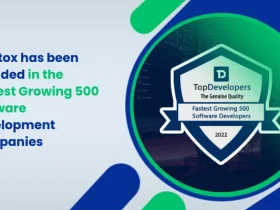



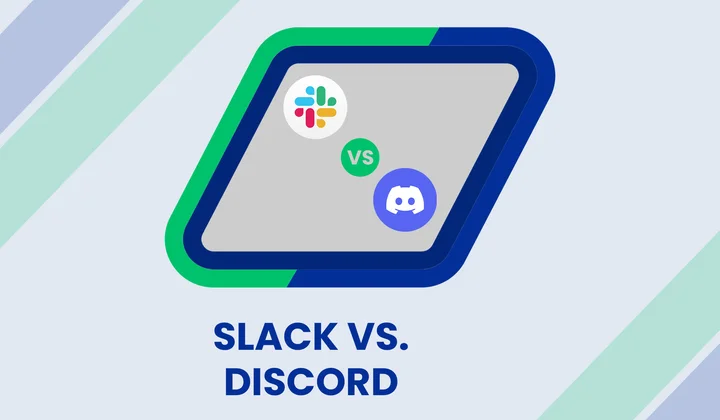
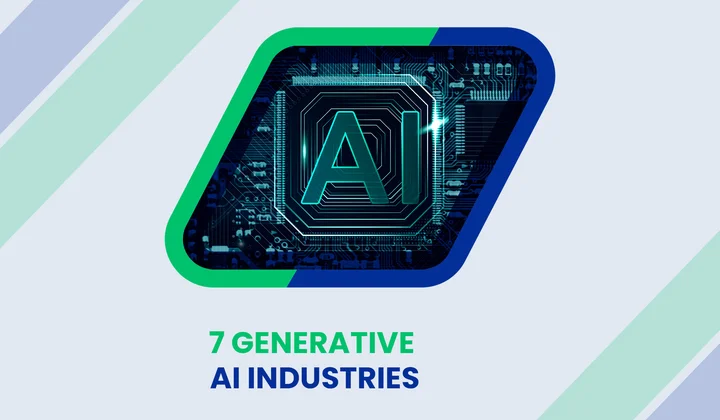
Share your thoughts about this blog!